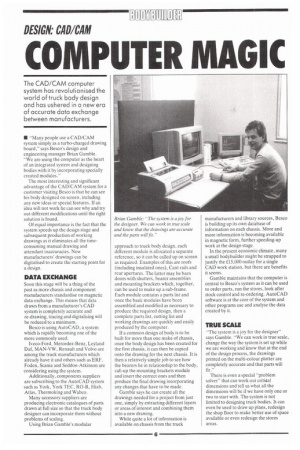COMPUTER MAGIC
Page 90

If you've noticed an error in this article please click here to report it so we can fix it.
The CAD/CAM computer system has revolutionised the world of truck body design and has ushered in a new era of accurate data exchange between manufacturers.
• "Many people use a CAD/CAM system simply as a turbo-charged drawing board," says Besco's design and engineering manager Brian Gamble. -We are using the computer as the heart of an integrated system and designing bodies with it by incorporating specially created modules."
The most interesting and significant advantage of the CAD/CAM system for a customer visiting Besco is that he can see his body designed on screen, including any new ideas or special features. If an idea will not work he can see why and try out different modifications until the right solution is found.
Of equal importance is the fact that the system speeds up the design stage and subsequent production of working drawings as it eliminates all the timeconsuming manual drawing and attendant inaccuracies. Now manufacturers' drawings can be digitalised to create the starting point for a design.
DATA EXCHANGE
Soon this stage will be a thing of the past as more chassis and component manufacturers standardise on magnetic data exchange. This means that data drawn from a manufacturer's CAD system is completely accurate and re-drawing, tracing and digitalising will be reduced to a minimum.
Besco is using AutoCAD, a system which is rapidly becoming one of the more commonly used.
Iveco-Ford, Mercedez-Benz, Leyland Daf, MAN-VW, Renault and Volvo are among the truck manufacturers which already have it and others such as ERF, Foden, Scania and Seddon-Atkinson are considering using the system.
Additionally, components suppliers are subscribing to the AutoCAD system such as York, York TEC, RO-R, Hiab, Atlas, Thermoking and Wabco.
Many accessory suppliers are producing electronic catalogues of parts drawn at full size so that the truck body designer can incorporate them without problems of scaling.
Using Brian Gamble's modular approach to truck body design, each different module is allocated a separate reference, so it can be called up on screen as required. Examples of this are roofs (including insulated ones), Cant rails and rear apertures. The latter may be barn doors with shutters, bearer assemblies and mounting brackets which, together, can be used to make up a sub-frame. Each module contains a parts list and once the basic modules have been assembled and modified as necessary to produce the required design, then a complete parts list, cutting list and working drawings are quickly and easily produced by the computer.
If a common design of body is to be built for more than one make of chassis, once the body design has been created for the first chassis, it can then be copied onto the drawing for the next chassis. It is then a relatively simple job to see how the bearers lie in relationship to the body, call-up the mounting brackets module and insert the correct ones and then produce the final drawing incorporating any changes that have to be made.
Gamble says he can create all the drawings needed for a project from just one, simply by extracting different layers or areas of interest and combining them into a new drawing.
While quite a lot of information is available on chassis from the truck manufacturers and library sources, Besco is building up its own database of information on each chassis. More and more information is becoming available in magnetic form, further speeding-up work at the design stage.
In the present economic climate, many a small bodybuilder might be strapped to justify the £15,000 outlay for a single CAD work station, but there are benefits it seems.
Gamble maintains that the computer is central to Besco's system as it can be used to order parts, run the stores, look after stock control and re-ordering. AutoCAD software is at the core of the system and other programs use and analyse the data created by it
TRUE SCALE
"The system is a joy for the designer" says Gamble. "We can work in true scale, change the way the system is set up while we are working and know that at the end of the design process, the drawings printed on the multi-colour plotter are completely accurate and that parts will fit."
There is even a special "problem solver" that can work out critkal dimensions and tell us what all the dimensions will be if we have only one or two to start with. The system is not limited to designing truck bodies. It can even be used to draw up plans, redesign the shop floor to make better use of space available or even redesign the stores areas.
























































































































